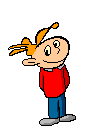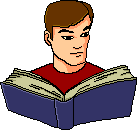![]()
Operationalizations of "Behavior"
Classification of Verbs as Observable or Not
| Assuming animation is enabled you can see this ballerina moving about. Ballet experts could give a precise label for each movement. I have to say she is twirling, bending her knees and twirling again. |  |
|
Here you can see the person's mouth dropping open, his eyes widening, his hair standing on end and his arms straightening with his fingers spreading. Those are observable behaviors. It is an inference, not a behavior, to say he is "feeling shock or surprise." Surprise is an internal experience that cannot be objectively corroborated and is a label that different individuals impose in various ways. Maybe I paid the little cartoon guy a sum of money to act surprised and he is really quite calm. Emotional inferences are common because it is easier to take a guess than it is to detail all the component behaviors. Emotion words are summary words. Forgetting that leads to problems in communication and in altering behavior. |
 |
|
In this one you can see the persons head and eyes moving from one page to the other (behavior), but you cannot see if he is reading (without clarification is not a behavior). |
 |
| Directly Observable | to draw, press a lever, point to, walk, underline, write, color, lift, say, chew, blink, bark, |
| Not Observable | to conclude, feel, want, think, concentrate, be aware, apply, appreciate, wonder, analyze, solve, test, learn, understand, know, like |
|
Require elaboration or clarification to be observable |
to measure, play, give, finish, see, demonstrate, find, subtract, make, read, perform, complete, identify, borrow, change |
This is one way to categorize behaviors. Any particular behavior may have aspects fitting in several categories.
| Behavior | Description | Examples |
| Appropriate | Achieves necessary and desired goals without infringing on the rights and needs of others. Includes appropriate emotional responses. | Maintains healthy eating habits; Obtains satisfaction for a service problem without demeaning others. |
| Deficit | Lacks skill or knowledge needed for performing the behavior | Ignorant about effects of caffeine on health; Being illiterate or innumerate; passive responding in social situations |
| Excess | Too much of a behavior | Drinking until passed out. Overeating. Smoking. |
| Other Inappropriate | The behavior occurs at a time or place that is inappropriate. If it occurred under other circumstances the behavior would be acceptable. | Bed-wetting; exhibitionism |
|
Maladaptive Emotional |
Capable of performing but has a stronger than typical autonomic system reaction, most often is fears and anxieties. | Shyness; Test Anxiety |
These materials were adapted from a variety of sources, including:
Verbs: Alberto, P. & Troutman, A. (1999). Applied Behavior Analysis for Teachers. Englewood Cliffs, NJ: Prentice-Hall.
Types of Behavior: Krumboltz, J. & Thorensen, C. (1976). Counseling Methods. NY: Holt.
Contact the author with comments or questions about this site by following the directions at this page (which will open in a new window.)